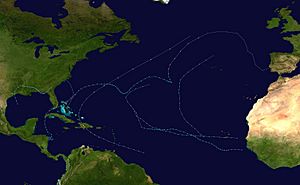1987 Atlantic hurricane season facts for kids
 |
|
| Season summary map | |
| First storm formed | May 25, 1987 |
|---|---|
| Last storm dissipated | November 4, 1987 |
| Strongest storm | Emily – 958 mbar (hPa) (28.3 inHg), 125 mph (205 km/h) |
| Total depressions | 14 |
| Total storms | 7 |
| Hurricanes | 3 |
| Major hurricanes (Cat. 3+) | 1 |
| Total fatalities | 10 |
| Total damage | $73 million (1987 USD) |
| Atlantic hurricane seasons 1985, 1986, 1987, 1988, 1989 |
|
The 1987 Atlantic hurricane season was a period when tropical storms and hurricanes formed in the Atlantic Ocean. It officially started on June 1, 1987, and ended on November 30, 1987. However, storms can sometimes form outside these dates. For example, the first storm of this season, Tropical Depression One, formed a bit earlier on May 25.
This season had an average number of storms. But many of them were not very strong. There were only three hurricanes, and just one of those became a major hurricane. A major hurricane is a very powerful storm with strong winds.
Contents
Understanding Storms in 1987
During the 1987 Atlantic hurricane season, several different types of storms formed. These included tropical depressions, tropical storms, and hurricanes. Each type has different wind speeds and strength.
Tropical Depressions
A tropical depression is the weakest type of tropical cyclone. It has organized thunderstorms and a clear center of circulation. Its winds are less than 39 miles per hour (63 km/h). In 1987, there were several tropical depressions that did not grow stronger.
- Tropical Depression One
- Tropical Depression Four
- Tropical Depression Six
- Tropical Depression Eight
- Tropical Depression Nine
- Tropical Depression Eleven
- Tropical Depression Fourteen
Tropical Storms
A tropical storm is stronger than a tropical depression. Its winds are between 39 and 73 miles per hour (63–118 km/h). When a storm reaches this strength, it gets a name.
- Tropical Storm Two
- Tropical Storm Bret
- Tropical Storm Cindy
- Tropical Storm Dennis
Hurricanes
A hurricane is the strongest type of tropical cyclone. Its winds are 74 miles per hour (119 km/h) or more. Hurricanes are given names to help people track them.
- Hurricane Arlene
- Hurricane Emily
- Hurricane Floyd
Hurricane Emily: The Strongest Storm
Hurricane Emily was the strongest storm of the 1987 season. It became a major hurricane, meaning it reached Category 3 or higher on the Saffir–Simpson hurricane wind scale. Emily had very strong winds and caused some damage.
No Names Retired
Sometimes, if a hurricane causes a lot of damage or deaths, its name is "retired." This means the name will not be used again for another storm. For the 1987 season, no storm names were retired. This suggests that while there were storms, none caused extreme, widespread disaster.
|
Tropical cyclones of the 1987 Atlantic hurricane season |
||||||||||||||||||||||||||||||
|
|
|||||||||||||||||||||||||||||
|
|
||||||||||||||||||||||||||||||
See also
In Spanish: Temporada de huracanes en el Atlántico de 1987 para niños

